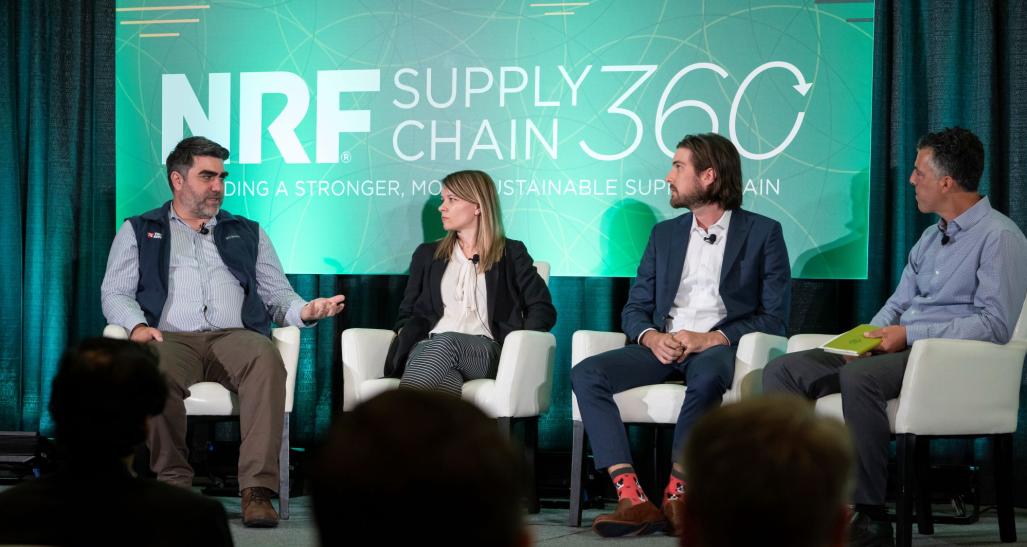Article posted by NRF
The NRF Supply Chain 360 conference and expo was held in Cleveland June 20-21, 2022. It explored the modes and methods needed to build a stronger, more sustainable supply chain and ensure resiliency in challenging times. Learn more about the conference here.
The future of retail supply chains is becoming clear, and that future will require retailers to have better visibility into the sustainability of their supply chains. As retailers race to meet consumer and investor demands for more sustainable products, they are learning that their most significant business opportunities and risks originate deep within supply chains.
Walgreens and Tractor Supply Company outlined the importance of improved supply chain transparency in a recent panel at the inaugural NRF Supply Chain 360 conference. The retailers were joined by The Sustainability Consortium, a sustainability-focused global nonprofit, and Supply Shift, a service provider that manages the THESIS supply chain transparency tool developed by The Sustainability Consortium. THESIS is already being used by Walgreens, Tractor Supply Co. and more than a dozen other retailers and hundreds of suppliers.
NRF Supply Chain 360
Did you miss the event? Catch up on what you missed at the 2022 event recap.
Today’s retailer sustainability initiatives, according to the Supply Chain 360 panelists, have moved beyond early sustainability efforts that focused only on retail operations. Those initial efforts focused on improving fuel and energy efficiency and reducing waste. While they remain important, those efforts are no longer sufficient.
Modern sustainability efforts are expanding beyond a sole focus on retail operations to a broader focus on retail sales. The sustainability scope expanded as consumers, investors, executives and other stakeholders realized that 90 percent or more of the retail industry’s sustainability impacts occur within retail supply chains. They originate from the materials and manufacturing processes used to make the products, to package and transport them, and from how consumers use and ultimately dispose of the products they buy.
As Walgreens and Tractor Supply Co. explained during the panel, understanding that retail supply chains create the most significant sustainability risks and opportunities creates new challenges because the wide variety of products they sell each have dramatically different sustainability profiles. The way over-the-counter medications are manufactured and delivered for Walgreens has very different kinds of sustainability impacts than that of the materials and manufacturing processes used to make the plush toys Walgreens also sells.
The Sustainability Consortium’s THESIS tool, powered by proprietary collaboration and reporting software from Supply Shift, enables retailers to understand the 10 to 15 most critical sustainability “hot spots” that exist within supply chains for specific product categories. Retailers can use the information to develop strategies and make decisions to help them meet their sustainability and broader business goals.
More on sustainability
Explore more supply chain content, webinars, networking events and resources from NRF.
Tractor Supply Co. uses THESIS data to make strategic decisions about how it will meet its climate change emissions reduction goal. As it looks at ways to reduce the emissions it directly controls (scope 1 and 2 emissions) and the scope 3 emissions generated by its suppliers and consumers, Tractor Supply Co. recognizes a need to adopt different strategies for different product categories.
The sustainability issues associated with animal feed, for example, occur primarily from the agricultural practices used to grow the grains or raise the meat-based protein sources and from the fuels used to transport the feed to consumers. Those sustainability impacts are very different than the impacts from a product like a zero-turn lawn mower where the most significant impact is not how the product is made or transported but by which fuel consumers use to power the mower.
As Tractor Supply Co. explores ways to reduce scope 3 emissions, it might focus on encouraging suppliers to adopt improved agricultural practices in its animal feed supply chains. With lawn tractor suppliers, however, it might instead ask suppliers to switch to advanced battery technologies to power the lawn tractors instead of gasoline-powered motors. Switching the fuels used by the tractors might be the best way for Tractor Supply Company to reduce the climate emissions associated with those supply chains — if performance and costs continue meeting or exceeding consumer expectations.
When Tractor Supply Co. joined The Sustainability Consortium, the NGO did not yet have a sustainability profile for zero-turn lawn mowers and so the NGO developed one. It is now one of more than 600 product profiles from The Sustainability Consortium, covering about 90 percent of products consumers buy, that retailers can use with suppliers to collect and analyze sustainability metrics.
During NRF Supply Chain 360, the panelists emphasized the value of pre-competitive collaboration among retailers on sustainability efforts and tools. Many retailers share Tier 1 suppliers and there is even more overlap among retail suppliers deeper in supply chains. The THESIS tool and Supply Shift software allow retailers to focus their sustainability questions on the most critical sustainability hot spots within each supply chain and to ensure that retailers are seeking the same information in the same format using the same sustainability metrics.
That means suppliers are hearing consistent signals from their customers about which sustainability metrics are most important. It also means suppliers can complete a sustainability self-assessment from one retailer and use it to respond to requests from other retailers. The result, according to both The Sustainability Consortium and Supply Shift, is that retailers get more accurate and consistent information from their supply chain partners and suppliers can respond to a common set of questions and reduce the volume of duplicative paperwork from multiple retailers.

